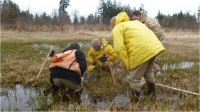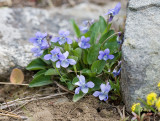Newly arrived Taylor’s checkerspot butterflies thriving at MCCCW
By Graduate Research Associate Dennis Aubrey
After a more than a year of preparation, the butterfly program at Mission Creek Corrections Center for Women is finally rearing endangered butterflies! Mary Jo Andersen brought 755 post diapause Taylor’s checkerspot larvae from the Oregon Zoo in early March, and when they emerged from their blue cooler, they found that they had been transported directly to caterpillar paradise. Cool nights and warm bright days, no rain but perfect moisture, tender hand-picked leaves delivered fresh every morning, no predators, vehicles, or hard freezes; what more could a caterpillar ask for? Many of them headed directly for the fresh leaves and began eating vigorously, much to Mary Jo’s amazement.
Part of the beauty of the new facility is the quality of the light. One of the limiting variables in rearing butterflies is UV light exposure, and the structure was built with that in mind. When the caterpillars arrived conditions were perfect and they responded immediately.
Of the 755 that Mary Jo brought, 600 were released a week later onto a Joint Base Lewis-McChord reintroduction site and 155 continue to develop at the prison. Because of the conditions, they have been growing and molting more quickly than at the Oregon Zoo, and some have already pupated. If anything, conditions may be too perfect!
As one way of assessing the “quality” of the conditions, inmates will be weighing and measuring adult butterflies when they emerge. This will be used to compare their weights with historic averages from the Oregon Zoo, because it is generally very challenging to rear full sized adults in captivity. One of the original goals of the facility design was to more closely mimic natural conditions in order to produce butterflies as large as wild-caught individuals, something Oregon Zoo has been unable to accomplish.
Another part of what we hope is our formula for success is the constant and thorough care that inmates can provide. The four currently involved with the project care for their charges meticulously, and we hope that also helps to produce natural-sized, healthy animals.
In addition to TLC, inmates also keep highly detailed records of their observations. In fact, they are now filling their third notebook with records beyond those they are asked for. They even hand-draw spreadsheets with rulers when details they want to record are not covered by the official forms.
This careful manner will soon become critical when they undertake an upcoming research project examining host plant preference. This will attempt to show which native prairie plants are most valuable to the butterfly as a resource in restoration plots. Not only is this critical, relevant research, but it also involves a second endangered species! One of the plants to be examined is state-endangered golden paintbrush (Castilleja levisecta), so this spring inmates will be caring for two endangered species at Mission Creek!
- Hard at work in the butterfly house at MCCCW.
- Graduate Research Associate Dennis Aubrey on release day at JBLM.
- Biologist Mary Linders releases Taylors checkerspot butterflies at JBLM.
- Happy caterpillars.
To donate to SPP and support the rearing of endangered butterflies in Washington state, click here.

















